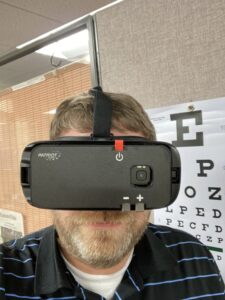By Peg Lopata, Contributing Writer

REGION – Sometimes the profusion of apps, new devices and other tech tools could make you dizzy―but choices are good, especially for the blind or visually impaired.
Said Alexander Pooler, director of assistive technology, at the Massachusetts Commission for the Blind (MCB), “The availability of many different technologies can be overwhelming. But our department is always excited about technology because it seems like there is something new for our community every year.”
Navigation advancements
Navigating the world from your own space to the world at large takes some learning if you’re blind. One development in the works is a wearable navigation device that MCB is hoping to bring to the marketplace in Massachusetts.

Photos/Submitted
Pooler explained, “This device―first of its kind―will aid in community mobility. It was originally tested by the first blind runner to participate in the New York City marathon unassisted.”
These kinds of devices that make access everywhere for the blind and visually impaired are vitally important, many in the community believe.
“We’re really hoping for self-driving cars,” said Jerry Feliz, director of the Assistive Technology Training Center at the Massachusetts Association for the Blind and Visually Impaired in Brookline. “Self-driving cars will open up a lot of doors. And help so much with making social connections. It’ll really make a difference.”
Progress in other applications
For the blind and visually impaired, optical character recognition (OCR) and text-to-voice devices have been notable advancements. OCR sees words and with text to voice, says aloud what is printed. Another new technology allows people with low vision to don a wearable device that dramatically magnifies and improves their ability to see things.

Gayle Yarnall of Amesbury uses, among other smart phone apps, one called Colorino which tells you what colors things are. If you need a person to quickly see something for you, there’s a free app called BeMyEyes that connects you by smart phone with a sighted person anyplace in the world who speaks your language.
For the most fun device, Feliz said he turns on his Apple TV.
“I love it,” he said enthusiastically. Not only does Feliz love his Apple TV, he feels that Apple has been a leader in integrated accessibility, or in other words, has built-in features that make something work especially well for those who are blind or visually impaired.
“The most helpful advancement for me,“ explained Feliz, “are devices that are accessible from the beginning. When that’s done, the product is going to be a lot better.”
Basics matter
But whether it’s an app that does something like enabling you to hear a label read aloud on a prescription bottle, or something less critical, Feliz thinks it’s still important for the blind to not get too caught up in the latest tech devices.
And Yarnall added, “Some of this stuff is freakishly expensive.”
“There’s a danger with technology,“ added Feliz.
He believes these devices can be really good―but he also believes knowing how to use your cane well is very important, and human-centered assistance is helpful, too.
Connecting with others creates a richer world for anyone―but for those with limits on mobility, connections may not come easy. Devices may seem to help get to a point where you don’t need any help from anyone. But Feliz noted, it’s interdependence with others, in fact, that leads to greater independence.
People-to-people connections, fancy devices aside, are ultimately what many people feel make lives full and more meaningful―no matter how much or how little you can see with your eyes.
Learn more about the blind or visually impaired here:
www.mass.gov/orgs/massachusetts-commission-for-the-blind
RELATED CONTENT:
Seniors embrace company’s virtual reality experience (fiftyplusadvocate.com)
Joining the digital world: Embracing new technology – Fifty Plus Advocate












